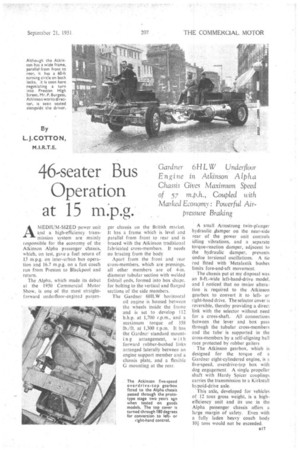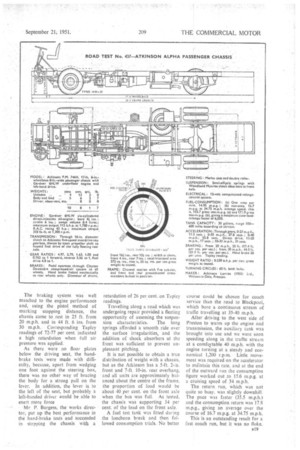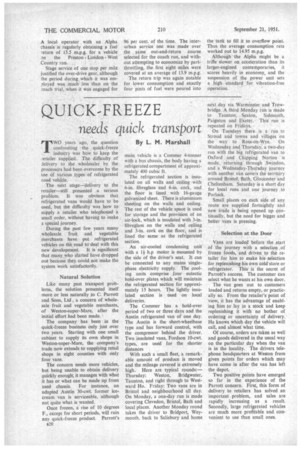46-seater Bus Operation at 15 m.p.g.
Page 51

Page 52

Page 53

Page 54

If you've noticed an error in this article please click here to report it so we can fix it.
Gardner 6H L W Underfloor Engine in Atkinson Alpha Chassis Gives Maximum Speed of 57 m.p.h., Coupled with Marked Economy Powerful Air
pressure Braking
By
L.J.COTTON,
.I.R.T.E.
AMEDIUM-SIZED power unit and a high-efficiency transmission system are mainly responsible for the economy of the Atkinson Alpha passenger chassis, which, on test, gave a fuel return of 15 mpg. on inter-urban bus operation and 16.7 m.p.g. on a fast coach run from Preston to Blackpool and return.
The Alpha, which made its debut at the 1950 Commercial Motor Show, is one of the most straightforward underfloor-engined passen
ger chassis on the British market. It has a frame which is level and parallel from front to rear and is braced with the Atkinson traditional fabricated cross-members. It needs no bracing from the body Apart from the front• and rear cross-members, which are pressings, all other member S are of 4-in, diameter tubular section with welded fishtail ends, formed into box shape. for bolting to the vertical and flanged sections of the side members, The Gardner 6HLW horizontal oil engine is housed between the wheels inside the frame and is set to develop 112 b.h.p. at 1,700 r.p.m., and a maximum torque of 358 lb./ft. at 1,300 r.p.rn. It has the Gardne7 standard mount i ii g arrangement, wit h forward rubber-bushed links arranged laterally between an engine support member and a chassis plate, and a flexible G mounting at the rear.
A small Armstrong twin-plunger hydraulic ilamper on the near-side rear of the power unit controls idling vibrations, and a separate torque-reaction damper, adjacent to the hydraulic damper, prevents undue torsional oscillations. A tie rod fitted with 'Metalastik bushes limits fore-and-aft movement.
The chassis put at my disposal was an 8-ft-wide left-hand-drive model, and I noticed that no major alteration is required to the Atkinson gearbox to convert it to leftor right-hand drive. The selector cover is reversible, thereby providing a direct link with the selector without need for a cross-shaft All connections between . the lever and box pass through the tubular cross-members and the tube is supported in the cross-members by a self-aligning ball race protected by rubber gaiters The Atkinson gearbox, which is designed for . the torque of a Gardner eight-cylindered engine, is a five-speed, overdrive-top box with dog engagement A single propeller shaft with Hardy Spicer couplinQ,, carries the transmission to a Kirkstall hypoid-drive axle.
This axle, developed for vehicles of 12 tons gross weight, is a highefficiency unit and its use in the Alpha passenger chassis offers a large margin of safety. Even with a fully laden heavy coach body 10i tons would not be. exceeded.
Overseas operators usually prefer the air-pressure braking system, and the Atkinson, with Clayton Dewandre equipment, has an enginedriven compressor and a reservoir of sufficient size to operate both the brakes and the door gear, Individual operating cylinders are fitted to each wheel, those at the front being 5i ins, in diameter and those at the rear 5 ins. Moulded brake facings were fitted.
The springs at the front and rear are 5 ft. 2 ins. long. Woodhead Munroe shock absorbers are used only at the front. Safety precautions in the suspension system include a full-length damper plate, wrapped round the spring eyes, and a limiting buffer incorporated in the fabricated hanger bracket to prevent main-leaf spread in the event of a fracture.
To obtain maximum air flow, the radiator is secured in front of the axle below frame level, the fan unit and drive being integral with the
assembly. Tubes a detachable Withnell type are used and are secured by Isherwood bushes. The fan is a simple six-bladed pressing driven from the engine through a shaft with Layrub couplings.
On the weighbridge the chassis tipped the scales at 4 tons 14 cwt., with eight gallons of fuel in the tank and the spare wheel housed amidships. Five 1-ton weights and fixings, aggregating 5 tons 61cwt., and a driver and five passengers brought the running weight to 10 tons 8+ cwt. Allowing 3 tons for the body, the overall weight is equal to carrying 46 passengers in a singledecker or a full load in a coach, with 7i cwt. to spare for luggage.
The chassis had completed a 90mile post-assembly test before being passed over to me, and I soon found that the brakes, clutch and gear selector were nicely adjusted and
n18
relatively free from high spots. After leaving the works on the outskirts of Preston, the chassis was headed towards Sheep Hill for climbing tests.
I was perched on a weight beside the driving seat and, momentarily forgetting the overdrive, I was surprised to see the driver disengage the clutch and change up into yet another ratio at 37 m.p.h For long
distance driving the overdrive gear is invaluable. Even at 45 m.p.h. the engine, with 4.8-to-1 final-drive ratio and 10-in. section tyres, is operating at a mere 1,340 r.p.m., which is well within the lowest part of the economy curve.
Sheep Hill is a moderate climb, averaging 1 in 11 and has a hillock where the Tapley meter registered 1 in 8 This required second gear from a rolling start and the lowest ratio was employed during a stop-start trial. The engine was far from being near normal working temperature during the climb and thermometer readings were of no great value.
Then followed a cross-country drive to the Southport road for acceleration tests, which were made only with great difficulty on the outward runs because of intensive coach traffic. Judged by present standards, the 6HLW engine is a moderate-sized unit, but, as the results show, it has a high performance. There are many advantages to be gained by employing a unit ot this size, particularly in its economy and weightsaving, so long as acceleration and climbing ability are not adversely affected.
Low gear is for emergency starts on gradients, and in my tests I used second, third and fourth (directdriire) ratios. With well-timed gear changes, the Atkinson reached 30 m.p.h. from rest in 27.8 secs., and engaging the overdrive at 35 m.p.h., the speedometer needle passed the 40 m.p.h. mark in under 60 secs. At a later opportunity I discovered the maximum speed to be 57 m.p.h. on level ground, but allowing a slight run-up on the fuelpump governor with subsequent use, the Alpha should be capable of covering a mile a minute. The braking system was well matched to the engine performance and, using the pistol method of marking stopping distance, the chassis came to. rest in 25 ft. from 20 m.p.h. and in 44 ft. 6 ins. from 30 m.p.h. Corresponding Tapley readings of 72-77 per cent. indicated a high retardation when full air pressure was applied.
As there were no floor plates below the driving seat, the handbrake tests were made with difficulty, because, apart from wedging one foot against the steering box, there was no other way of bracing the body for a strong pull on the lever. In addition, the lever is to the left of the seat, but probably a left-handed driver would be able to exert more force
• Mr. P. Burgess, the works director, put up the best performance in the hand-brake tests and succeeded in stopping the chassis with a
retardation of 26 per cent. on Tapley readings.
Travelling along a road which was undergoing repair Provided a fleeting opportunity of assessing the suspension characteristics. The long .springs afforded a smooth ride over the surface irregularities, and the addition of shock absorbers at the front was sufficient to prevent unpleasant pitching.
It is not possible to obtain a true distribution of weight with a chassis, but as the Atkinson has a 5-ft. 2-in. front and 7-ft 10-in, rear overhang, and all units are approximately balanced about the centre of the frame, the proportion of load would be about 40 per cent. on the front axle when the bus was full. As tested, the chassis was supporting 34 per cent. of the load on the front axle.
A fuel test tank was fitted during the luncheon break and then followed consumption trials. No better
course could be chosen for coach service than the road to Blackpool, which bore a continuous stream of traffic travelling at 35-40 m.p.h.
After driving to the west side. of Preston to warm up the engine and transmission, the auxiliary tank was brought into use and we were soon speeding along in the traffic stream at a comfortable 40 m.p.h. with the engine turning at a steady and economical 1,200 r.p.m. • Little movement was required on the accelerator to maintain this rate, and at the end of the outward run the consumption figure worked out .to 15.6 m.p.g. at a cruising speed of 34 m.p.h.
The return run, which was not quite so busy, was slightly downhill. The pace was faster (35.5 m.p.h.) and the consumption return was 17.8 m.p.g., giving an average over the course of 16.7 m.p.g. at 34.75 m.p.h.
This is an outstanding result for a fast coach run, but it was no fluke, A local operator with an Alpha chassis is regularly obtaining a fuel return of 15.5 m.p.g. for a vehicle an the Preston London West Country run.
Stage service of one stop per mile justified the over-drive gear, although the period during which it was employed was much less than on the coach trial, when it was engaged for 96 per cent. of the time. The interurban service test was made over the . same out-and-return course selected for the coach run, and without attempting to economize by partthrottling, the first eight miles were covered at an average of 13.9 m.p.g.
The return trip was again notable for lower consumption and exactly four pints of fuel were poured into the tank to fill it to overflow point. Thus the average consumption rate worked out to 14.95 m.p.g.
Although 'the Alpha might be a trifle slower on acceleration than its larger-engined contemporaries, it scores heavily in economy, and the suspension of the power unit sets a high standard for vibration-free operation.




























































































